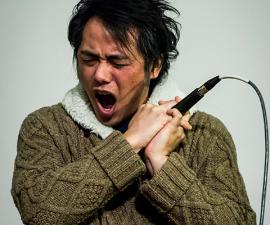

Research Expertise and Interest
music composition, decolonizing music, noise, sound installations, music of Japan, extended vocal techniques, overtone singing, musical culture of Japan, experimental improvisation
Research Description
Breath is at the ontological center of my art practice as a vocalist, and taking a cue from Robert Hass’ thesis that “poetry is: a physical structure of the actual breath of a given emotion,” my practice transposes this notion into music through physical valence. I believe that physical gestures are, indeed, mapped to given emotions. When we hear the operatic tenor, Pavarotti, sing a high C and linger there for tens of seconds, he not only suspends his breath, but, we, too, as listeners, suspend our breath. Physio-valence directs our bodies to vivify, in real time, the suspension of our breath in parallel with the music to which we are listening.
In my music, through circular breathing, that Pavarottian lingering moment is expanded to minutes, not seconds. The phenomenological reading of that lingering exacerbates traditional modes of analysis in terms of structural hearing. For example, in Tard, I hold my breath in a bowl of water for 2 minutes, as an analog to how I have felt my breath has been suspended since November 2016, as well as how I feel my voice as a person of color has been muted.
My piece foregrounds my body as a specific instrument. Much of my music is “person-specific” wherein the intricacies of performance practice are brought into focus in the technical achievements of a specific individual fused, inextricably, with that performer’s aura. In an era in which we are increasingly rendered anonymous through digitization, Person-Specificity stands against the normative business practice of neocolonial transportability in Classical Music, and says, no, you cannot replace people who look like me.
If one does not consider the voice an instrument, then, the megaphone is my main instrument. I started using the megaphone, when I started performing in large spaces, with complex architectural features, which afforded the possibility of a counterpoint of resonances. Armed with a megaphone, I am mobile and can incorporate the narrative possibility of movement in a space, direct my sound in different directions, at different structural materials, and angles. I can play with various lengths of echoes. And articulating the resonant frequencies of different locations in a space, means that architecture, too, can be read as harmonic structure. I have developed an arsenal of vocal techniques specific to the megaphone. For example, a kind of slap tongue whose attack is followed by a multiphonic drone shaped by changing the vowel shapes within my mouth, but the shapes are vowels that don’t exist in any language. I have also learned to control the bandwidth of the multiphonic with the shape of my mouth, and I can also sing in counterpoint or in augmentation with the shaped feedback multiphonic by humming into my nasal cavity. There are other techniques which involve ingressive singing, which, in alternation with exhaled techniques, allows me to circular-breathe.
My art reaches extensively across disciplines. I have collaborated with artists and architects. For the artist, Angela Bulloch, I created several audio installations (driven by custom software), which provide audio input that affect the way her mechanical drawing machine sculptures draw. These works were exhibited at Art Basel as well as at Angela’s solo exhibition at the Wolfsburg Castle.
My sound installations algorithmically transform the trace of my voice in a manner that instrumentalizes the physicality of the architectural presence. For example, in Jericho Mouth, for the Inside-Out Music in Beijing, China, I installed PAs in a hollow chamber inside a wall structure algorithmically playing recordings of my sub-tone singing. The sounds are loud enough and low enough that it shakes the building. It was then palpable to the audience outside that the building IS an instrument.
In a recent work in Taiwan, Presence, a site-specific sound art installation performance, working with a team of students, we interviewed a group of “aunties” in NeiLi (sex workers, many of whom are of an advanced age). We asked them about their happiest moments, favorite music, and food, simple questions, in hopes of getting a more human picture of them. One of the aunties told us that her happiest moment in life was when she gave birth to her child, because it also came with pain. Another lady, told us that her favorite singer was Jiang Hui (江蕙), and that her favorite song was After Home (家後). We installed audio recordings of our experience from the weeklong workshop (Jiang Hui’s song, recordings of our colleagues’ working on their projects, street sounds, rain, and, a recording of an interview with an auntie) and spatialized them onto five floors of the Linggu Pagoda, a vertical crematorium. The sounds are presented in counterpoint with offerings of food and cigarettes - all having been mentioned to us in interviews with the aunties. “Presence,” as a title, also refers to our performance – being present in presenting the sounds and food offerings but not “performing” in the traditional sense. We enacted a middle ground between the living and the dead.